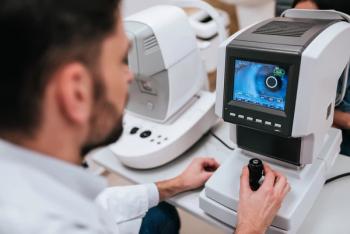
What every assistant needs to know about intravitreal injection
Understanding the whys and wherefores enables techs and doctors to work together effectively.
It seems most people hate the thought of needles. So just imagine the average patient’s reaction when you present a scenario in which a needle is injected into the eyeball. I do this to my patients many times, every single day, and I do it to the same patients as often as every month.
I currently use intravitreal Avastin (bevacizumab, Genentech), Lucentis (ranibizumab, Genentech), and Triesence (triamcinolone acetonide suspension, Alcon) to treat diseases such as wet macular degeneration, macular edema due to retinal vein occlusion, and diabetic macular edema. Newcomers Eylea (afilbercept, Regeneron) and Jetrea (ocriplasmin, ThromboGenics) have recently been introduced to the market. Eylea is a VEGF blocker, like Avastin, Lucentis, and Macugen (pegaptanib, Valeant). Its distinction is that after the first 3 monthly injections, the surgeon can decrease to inject every 2 months. Jetrea is the first enzymatic vitreolysis. Like the other drugs mentioned, Jetrea is administered by intravitreal injection. It may replace surgical intervention for some patients. Can you imagine that? An injection taking the place of surgery? I may add these medications to my armamentarium as well.
All of these options involving needles are clearly better choices than the alternative of going blind. I’ve been practicing for more than a decade and have seen remarkably positive outcomes of intravitreal injections, with few complications. Thankfully, my staff is well educated, and my technique is such that we rarely have complications.
Following are some tips I'd like to share on administering intravitreal injections successfully.
Sterile technique is key
Intravitreal injections are administered in our office rather than in an operating room. We originally intended to have a minor procedure room specifically used for cryotherapy and intravitreal injection. However, due to volume and patient flow, we decided to try using our exam rooms instead, and it’s working out well. We have three identical exam rooms and two Mayo trays that are used for injections and for angiography. Just like in the operating room, we are very careful to prevent infection. (Endophthalmitis, a serious infection inside the eye, is a risk with any ocular procedure.) I was an injecting physician for the MARINA Trial, one of the initial national studies on Lucentis. I use some of what I learned during that time in treating my patients today. Keeping complications at a minimum is important to me.
I am very careful to wash my hands between every patient encounter, and I require my staff to do the same. The staff also wipes down all equipment between uses and wipes down the counters at the end of the day. We do not allow food in exam rooms or on any countertops. Nonsterile instruments and supplies-such as Betadine, lidocaine, sterile gloves, extra packages of cotton tips, and extra needles-are placed on a plastic-backed towel on the counter. Sterile instruments and supplies-including the preloaded syringe of medicine, eyelid speculum, sterile cotton tips, and 4x4s -are dropped onto my Mayo tray. We place the Mayo tray near enough to the reclined patient that I can reach it.
Time management
After I examine, educate, and consent the patient, I go to the next exam room to see my next patient while my assistant sets up the counter and sterile tray for the first procedure. With her help, it takes less than 10 minutes from start to finish. I stand at the head of the patient. I like my Mayo tray to my right because I am right-handed. My assistant stands on the opposite side of the patient with Betadine in hand and sealed cotton tips at the ready. As I said before, my assistant knows the process well and knows exactly what to do.
We instruct the patient to try to relax, keep his hands away from his face, and not to speak. My assistant and I avoid speaking also. We’ve learned that the mouth is a main source of bacteria that can cause endophthalmitis. So, no talking, no coughing, and no sneezing. If a patient has a head cold, she must reschedule. If we suspect the patient will be chatty, then she must wear a mask. If one of my assistants has the sniffles, he is not allowed to assist. As silly as it sounds, we take this precaution very seriously. The other option would be for all of us to wear masks, but right now that doesn’t appear to be necessary.
It is an exciting time to be in the eyecare industry. Not long ago, the treatment options we offered our patients ranged from minimal to nonexistent. Today, we have more options and there will be even more to come. With diligence and precaution, we can really impact our patients' lives in a positive way.ODT
A private practitioner specializing in intravitreal injections finds that combining teamwork with organization enables the doctor and staff to manage patient care effectively.
Author Info
Mark E Tafoya, OD, MD, is in private practice in Waipahu, HI. Contact Dr. Tafoya at 808/676â4772.
Newsletter
Want more insights like this? Subscribe to Optometry Times and get clinical pearls and practice tips delivered straight to your inbox.













































